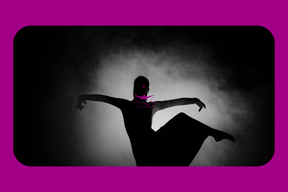One does not "do" Dance; Dance is a Space to Enter.
In Turkish, we use the verb "etmek" with dance, as in "dans etmek," implying dance is an action, something to be done. Dance is treated as a structure, something that requires execution, and we add the verb "etmek" to make it an act. In English, however, this is different; "dancing" is formed with the "-ing" suffix, transforming it into an ongoing action, reflecting the present moment.
We often think of dance as something we need to master through flawless movements and perfect forms. Modern society has framed dance this way, institutionalizing it through ballroom dance, ballet, and other structured forms. This has led us to see dance as form, perfection, and pure aesthetics. But here, again and again, we return to definitions. Our mind can only comprehend what it can define, whereas our emotions live and feel even what cannot be named.
When we look at the history of humanity and even prehistory, we see how dance occupied a significant space in life. From ancient artifacts, we can observe bodies in various postures, indicating that dance is as old as human history itself. Long before we developed language or written communication, we likely relied solely on movement and sound to express ourselves. Sometimes, I feel the thrill of imagining those times—there are undoubtedly pieces of information beyond our modern understanding.
These mysterious, unimaginable pieces of data were surely works of art in themselves, as art is a natural extension of human existence. We simply didn’t call it art back then; life itself was a ritual. When we consider the personal expression of movements and how common body language emerged from this, we can imagine the extraordinary creativity involved.
Throughout the history of rituals, we consistently see humanity's desire to connect the earthly with the divine, to unite the ground and the heavens. As the shapes of movements shift between this earthliness and divinity, what emerges is a dance. When an entire tribe "performs" this dance, it becomes a ritual. Dance is something to join, not something to shape. It is a state of being, a humble imitation of life itself. In other words, you don’t perform dance; you become part of it. Dance is already happening.
The body is the vehicle through which we enter dance. If we moved our bodies as naturally as needed, without the gray walls we’ve built around ourselves, our bodies would already be dancing. There would be no need to teach it. Movement is innate to the body; stillness belongs to death.
Therefore, dance cannot truly be taught. What can be done is to open a space, leaving clues for a journey of discovery. The body remembers its own movement, what has already been for hundreds of thousands, even millions of years, and from there, it connects to the universe—a seamless flow of movement, the harmony that creates existence, whose beginning is beyond our knowing.
When we surrender to dance, we can’t predict the doors it will open within us. We can’t describe it in words, and we likely won’t fully grasp it. But we feel more alive. Effort and definitions dissolve, and the ancient knowledge settles into our being. We find our rhythm, we lose it, and then we find it again, vibrating into something new. Throughout this process, we always stay close to ourselves.
One does not perform dance; dance is a space to be entered.
Movement is always there. We step aside and surrender.


